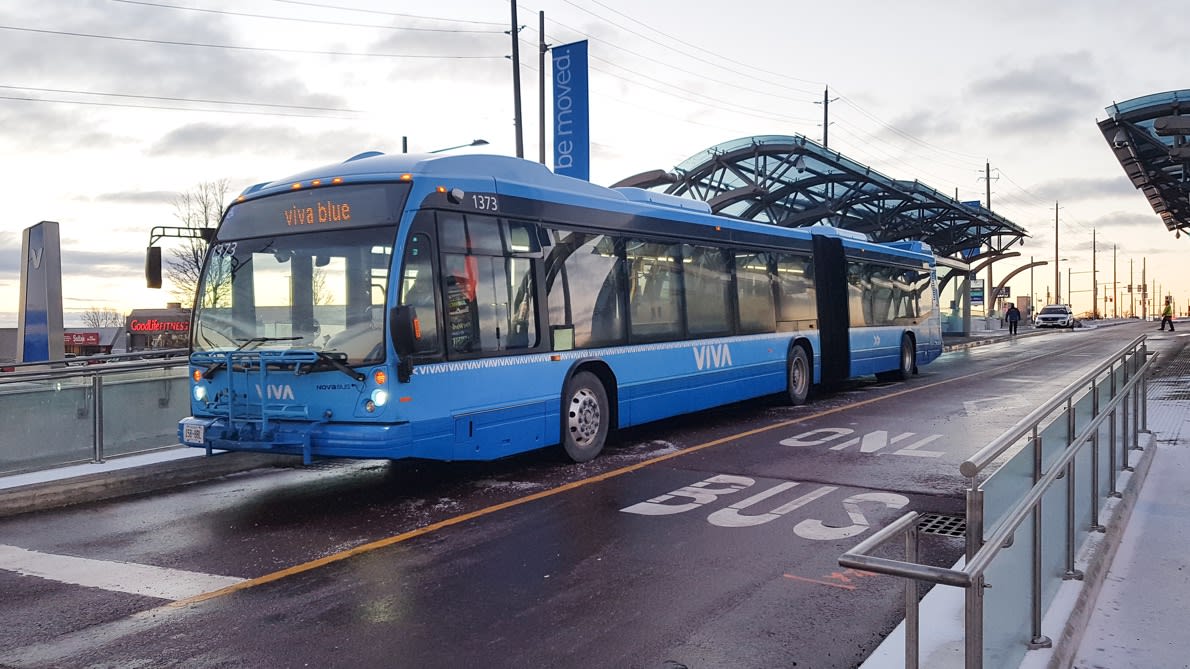Bus rapid transit in York Region opening up new avenues
The latest BRT to open is benefitting transit customers in Vaughan and Newmarket.
Jan 13, 2020
The wheels on the bus go round and round – just not always on the same road as the rest of traffic.
For generations of transit travellers, bus journeys were largely tucked into the ebb and stop and go flow of cars and trucks. But new bus rapid transit (BRT) projects – where the big people-movers are given their own path between or next to regular traffic lanes – are increasingly opening up new possibilities. As well as cutting commute times for people in York Region and beyond.
This week, buses started moving along Yonge Street on a new 2.4 kilometre long segment of the vivaNext rapidway in Newmarket, Ontario.
The vivaNext rapidway, when completed, will offer passengers 34 kilometres of fast reliable transit
Featuring dedicated lanes, raised bike lanes, and accessible stations, it’s all part of a larger BRT project that has been growing in York Region since 2013. With the recent segment openings, construction is complete, or nearly complete, on over 80 per cent of the 34 kilometres of rapidway projects.
“With the opening of the vivaNext rapidway projects in Vaughan and Newmarket, we’re achieving another exciting step in building an integrated bus rapid transit system in York Region,” said Liza Sheppard, director of the Bus Rapid Transit Program for York Region Rapid Transit Corporation.
These reimagined and dedicated bus routes allow people to get to work and back plus they can easily connect to GO train and TTC subway services.
The latest segment of the vivaNext rapidway opened this month in Newmarket, Ontario.
The birth of BRTs
BRT is an often overlooked rapid transit alternative that can provide communities with fast, reliable and cost-effective services with higher order transit capacities.
It’s a technology that is used in more than 165 cities around the world, from 19.6 million daily riders across Latin America and one in Jarkarta that moves accounts for more than 250 kilometres of routes around the Indonesian capital. There is even one in development in Kabul, Afghanistan. The first BRT dates back to 1974, in Curitiba, Brazil..
Most BRT routes are significantly faster and more reliable than regular bus service because they boast many of the best features of a light rail transit (LRT) line or subway system.
Some of the advantages of a BRT
- Buses run in their own dedicated lanes which means less traffic delays
- BRT projects cost much less to build compared to LRTs and subways
- More buses can easily be added if ridership increases
- New technologies like hybrid and electric buses can be deployed more easily
- Partial segments can open before the entire route is completed
- Customers board at platform level and pay at platform level
- ETC
These types of bus routes are also a way for communities to build transit ridership as density and demand grow.
The BRT route allows passengers to easily connect to GO train and TTC subway services.
Metrolinx has been delivering BRT transit projects in the Greater Golden Horseshoe for many years.
For example, the Mississauga BRT project was completed in 2017 in collaboration with the city of Mississauga. Buses now operate on reserved lanes on existing city streets and portions of Highway 403, that together form a continuous 18 kilometre route spanning most of the city of Mississauga, from Winston Churchill Boulevard in the west to the junction of Highways 401 and 427 in the east, on the border with Toronto. Service is provided by MiWay and GO Transit, with some stations providing connections to Brampton Transit and Toronto Transit Commission (TTC) bus services.
Ridership has been steadily increasing along the Mississauga BRT since it was completed in 2017
“The delivery of the vivaNext program is a key component of the Metrolinx Regional Transportation Plan and will provide enhanced connections across the region and new ways for people to travel to and from work, home and play,” said Richard Mulholland, director of Bus Rapid Transit for Metrolinx.
York Region Rapid Transit Corporation is responsible for designing and building 34 kilometres of dedicated lanes for bus rapid transit with connections to GO Transit, regional transit and the TTC’s Line 1 subway at the Vaughan Metropolitan Centre Station.
Rapidways along Highway 7 in Vaughan opened in 2017 and October 2019, Davis Drive in Newmarket opened in 2015, and Highway 7 segments through Markham and Richmond Hill opened in 2013 and 2014. Since then, York Region Transit (YRT), which operates the regional Viva service that utilizes the rapidways, has seen growth in ridership, with a 10 per cent increase in the first year of rapidway service on Highway 7 and a 62 per cent increase on Davis Drive in overall YRT and Viva service after the rapidway was complete.
How do these BRT routes compare to the buses that share the road with every other vehicle?
Travel time savings are 15 to 39 per cent faster on transit with completed rapidways, compared to the curbside service.
So the wheels on the bus keep going around – but just make much better time using a BRT.
To follow the progress of the vivaNext rapidways project, go to www.vivanext.com
(Editor’s note – This story was updated on Feb. 3, 2020, to reflect Brazil as the home of the first BRT.)
by Trina Melatti Crosstown Communications Manager
